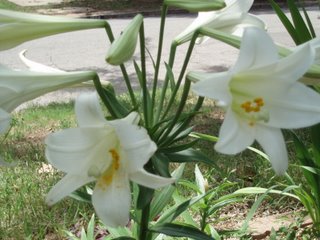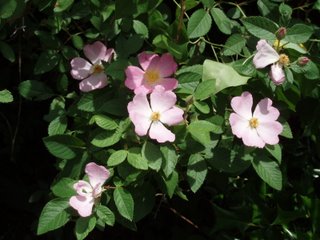What's in bloom.
Just a short post to show some of the things that are in bloom in my garden and in my mother's yard, yes I have been spending a lot of time in my mother's yard getting things ready for her to come home and now it looks like she'll have to go to an assisted living center for a while when she gets out of the hospital anyway. And this has to be short because I have to get the house ready for Jim and Susan to come over for dinner for Jim's birthday (Happy Birthday Jim!!!) I don't know how old Jim is today, isn't it amazing that people don't want to tell you anything if they know you blog. Actually, I haven't even talked to Jim since I found out that they were coming over tonight. Jim and I are the laid back ones in the group. We just do whatever Kathy and Susan tell us to do. Much safer that way.
Before I get to what's in bloom, I would like to welcome Shelly back to blogger-world. We have missed her posts and I am very happy she is feeling better!
Ok, what is in bloom:

 This is a close up of the flower of a chaste tree and a shot of the tree in the start of bloom. I love these things. They are one of the most beautiful plants I have.
This is a close up of the flower of a chaste tree and a shot of the tree in the start of bloom. I love these things. They are one of the most beautiful plants I have.

Asiatic lilies come in several colors and are always prolific bloomers. These are some out of my mother's yard since mine haven't started to bloom yet.

This is black and blue salvia. I love it for the interesting blooms, I hate it because unlike most salvia this isn't a "set-and-forget" plant. As a matter of fact, it is a water hog! Let it go one or two days without water and it droops something awful.

This old climbing rose is actually from my neighbor's yard. Roses depress me. I have a couple and they don't really take that much work, you just have to stay on top of things and as Kathy will tell you, I tend to get sidetracked and then my roses get black spot and powdery mildew and aphids, sigh.

Ok, technically this isn't a bloom. Actually, non-technically this isn't a bloom. No matter what I say, this is a leaf. But this is new growth on my ti plant and I just love the color show!
Ok, May is almost over (May is almost over? Where did May go?) and so here is the checklist for June (June already? No, it can't be June already! Where did May go? { Sorry, just a little denial there. It isn't just a river in Egypt you know.})
June
Vigorous, unwanted limbs should be removed or shortened
on new trees. Watch for forks in the main trunk and
remove the least desirable leader as soon as it is noticed.
Remain alert for insect damage. Add spider mites to the
list. Foliage of most plants becomes pale and speckled;
juniper foliage turns a pale yellowish color. Shake a
branch over white paper and watch for tiny specks that
crawl. Watch for 1st generation fall webworm. Pine needle disease treatments are needed again in mid-
June.
Cultivate and mulch. Mulching will reduce about 70 percent
of the summer yard maintenance.
Fertilize warm season grasses as per April instructions.
Dollar spot disease of lawns can first become visible in
mid-May. Make certain fertilizer applications have been
adequate before applying a fungicide.
Seeding of warm-season grasses should be completed
by the end of June to reduce winter kill losses.
Brown patch disease of cool-season grasses can be a
problem.
Meet water requirements of turf.
Post-emergent control of crabgrass and summer annual
grasses is best performed on young crabgrass plants.
Continue to water deeply as needed. Apply at least one
inch of water each time.
Softwood cuttings from new growth of many shrubs will
root if propagated in a moist shady spot.


1 Comments:
Thanks for the welcome back! I really am feeling much better. : )
Your yard must really be something to see. I love your pictures.
I do have a quick question. We live in a rural part of Norman on the N. side of Lake Thunderbird. This year we have an unbelieveably, huge, bumper crop of Poison Ivy. It is now in places that we've never had it before and where we did have it, it has exponentially multiplied!
We try to do everything organically and wildlife friendly (and people friendly) on our farm. Do you have a recommendation on how to rid or reduce our Poison Ivy crop? Also, my husband and I are both extremely reactive to Poison Ivy. Any suggestions would be greatly appreciated.
I certainly hope you're enjoying your weekend and have a wonderful upcoming week.
Shelly
Post a Comment
<< Home